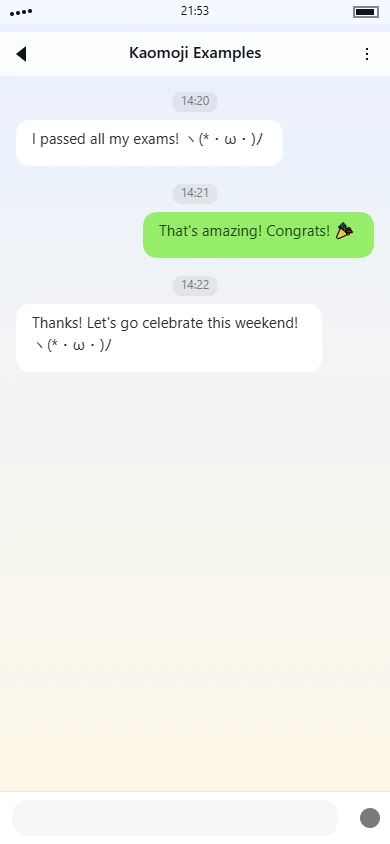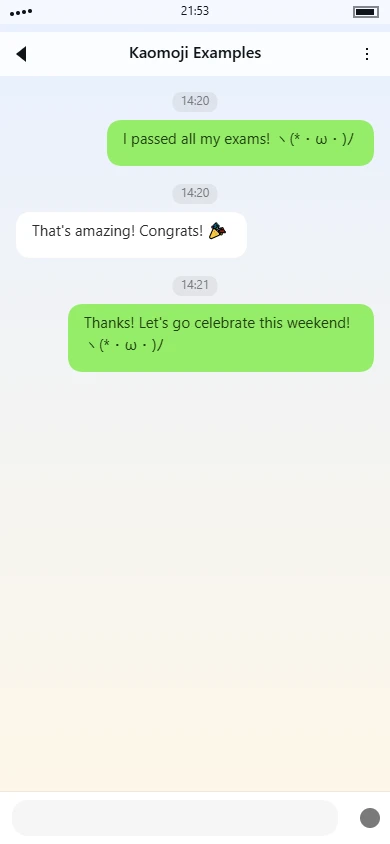(¬‿¬ ) kaomoji Meaning | Usage Tips

Overview
The kaomoji (¬‿¬ ) presents a distinctive facial expression that combines subtle smugness with a knowing look. Its visual structure creates a character with a slight tilt or asymmetry, giving the impression of someone sharing a private joke or having insider knowledge. The expression sits within parentheses that suggest a face outline, with the left side featuring a unique curved eye element and the right side showing a more conventional smiling mouth.
Symbol Breakdown
- Left parenthesis
: Forms the left boundary of the face, creating a rounded contour that frames the expression( - Logical NOT symbol
: Serves as the left eye, with its curved downward stroke suggesting a partially closed or squinting eye¬ - Underscore with breve
: Creates the mouth element, where the breve accent above the underscore gives a subtle upward curve to what would otherwise be a neutral mouth line‿ - Right parenthesis
: Completes the facial outline on the right side, mirroring the left boundary) - Space character: The trailing space after the closing parenthesis provides visual breathing room and separates the expression from surrounding text
Emotion & Aesthetic Analysis
This kaomoji conveys a sense of sly amusement or knowing complicity. The combination of the squinting left eye and the subtly curved mouth creates an expression that suggests the character is in on a secret or has hidden intentions. The overall effect is more mischievous than outright joyful, with a quality of restrained amusement.
Compared to more straightforward smiling kaomoji like (^_^) or (◕‿◕), this expression carries additional layers of meaning. It's less about pure happiness and more about shared understanding or subtle teasing. The asymmetrical nature—with one eye clearly defined and the other implied—adds to the impression of someone looking sideways or giving a knowing glance.
In practical use, this kaomoji often appears in contexts where the writer wants to suggest they know something the reader doesn't, or when sharing an inside joke. It can indicate playful deception, subtle flirtation, or the satisfaction of having figured something out. The expression manages to communicate complexity through relatively few characters, making it efficient for digital communication where space and clarity are considerations.
Tag categories
Use tags to quickly understand this kaomoji.
Usage guide
Usage Guide for (¬‿¬ )
The (¬‿¬ ) kaomoji, often called the "sly smile" or "mischievous grin," is one of the most versatile and expressive text-based emoticons in digital communication. Characterized by its raised eyebrows and subtle, knowing smile, this emoticon conveys a range of nuanced emotions from playful teasing and secret-sharing to confident smugness and lighthearted scheming. It's particularly effective in informal settings where tone might otherwise be difficult to convey through plain text alone. Whether you're chatting with friends, posting on social media, or engaging in online gaming communities, (¬‿¬ ) serves as a digital wink that says "I know something you don't" or "we're in on this together" without needing explicit explanation.
Common Use Cases
- When you've just pulled off a clever prank on a friend and want to acknowledge it playfully
- Responding to someone who's shared a secret or inside joke that only you two understand
- Teasing a friend about their crush or romantic interests in a lighthearted way
- After winning a game or debate through clever strategy rather than brute force
- When you're about to share some gossip or interesting news that hasn't spread yet
- In response to someone who's being obviously flirtatious but trying to play it cool
- When you've figured out the solution to a puzzle or problem before anyone else
- To acknowledge when someone has caught you in a minor white lie or exaggeration
- When planning a surprise party or gift for a mutual friend
- Reacting to someone's humble brag or subtle flex about their achievements
- In gaming chats after executing a perfectly timed move or discovering a hidden easter egg
- When someone shares an embarrassing story from their past that you find amusing
Example Conversations
-
Friend chat about weekend plans:
Alex: "I heard Sarah's throwing a party Saturday but didn't invite Mark" Jamie: "Yeah, she's still mad about what happened last time (¬‿¬ )"
-
Gaming community discussion:
Player1: "How did you get past the final boss so quickly?" Player2: "Let's just say I discovered a little trick with the inventory system (¬‿¬ )"
-
Workplace chat (casual colleagues):
Chris: "The boss seems unusually happy this morning" Taylor: "I may have mentioned the quarterly numbers are looking better than expected (¬‿¬ )"
-
Social media comment thread:
Post: "Just found my old diary from middle school... some interesting revelations" Comment: "I remember those days (¬‿¬ ) hope you're prepared for the embarrassment"
-
Flirty text exchange:
Person A: "I may have accidentally saved your number under 'cute barista'" Person B: "Accidentally, huh? (¬‿¬ )"
-
Family group chat:
Mom: "Who ate the last piece of cake?" Sibling: "Not sure what you're talking about (¬‿¬ )"
Important Considerations
While (¬‿¬ ) is excellent for casual communication, its mischievous undertones mean it should be used with consideration for context and relationship dynamics.
-
Avoid in professional settings - This emoticon is generally inappropriate for formal emails, official communications, or conversations with superiors where a more professional tone is expected. The playful implication might be misinterpreted as unprofessional or dismissive.
-
Know your audience - The meaning can vary significantly based on your relationship with the recipient. With close friends, it's clearly playful; with acquaintances, it might come across as oddly intimate or even creepy if the relationship isn't established enough for such casual teasing.
-
Cultural interpretation differences - While widely recognized in Western digital culture, the specific nuance might not translate perfectly across all cultural contexts. In some cultures, the "knowing smile" aspect might be perceived as more suspicious or untrustworthy rather than playful.
-
Timing matters - Using (¬‿¬ ) in serious conversations or during conflicts can appear dismissive or like you're not taking the situation seriously. Save it for lighthearted moments where humor is clearly welcome.
-
Platform context - On more formal platforms like LinkedIn or professional forums, this emoticon is generally out of place. It thrives best in casual environments like Discord, Twitter, Instagram, and personal messaging apps where informal communication is the norm.
Usage examples
Real conversation samples that feature this kaomoji.

Example 1

Example 2
Related kaomoji
You might also enjoy these kaomoji.